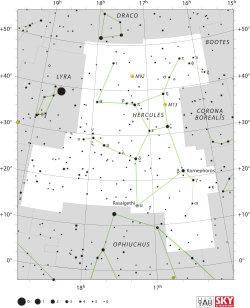Zeta Herculis
| Observation data Epoch J2000 Equinox J2000 |
|
|---|---|
| Constellation | Hercules |
| Right ascension | 16h 41m 17.16104 s |
| Declination | +31° 36′ 09.7873″ |
| Apparent magnitude (V) | 2.81 |
| Characteristics | |
| Spectral type | F9 IV + G7 V |
| U−B color index | +0.21 |
| B−V color index | +0.65 |
| Variable type | Suspected |
| Astrometry | |
| Radial velocity (Rv) | –68.43 km/s |
| Proper motion (μ) |
RA: –461.52 mas/yr Dec.: +342.28 mas/yr |
| Parallax (π) | 93.32 ± 0.47mas |
| Distance | 35.0 ± 0.2 ly (10.72 ± 0.05 pc) |
| Absolute magnitude (MV) | 2.65 |
| Orbit | |
| Period (P) | 34.45 yr |
| Semi-major axis (a) | 1.33" |
| Eccentricity (e) | 0.46 |
| Inclination (i) | 131° |
| Longitude of the node (Ω) | 50° |
| Periastron epoch (T) | 1967.7 |
|
Argument of periastron (ω) (secondary) |
111° |
| Details | |
| ζ Her A | |
| Mass | 1.45 ± 0.01 M☉ |
| Radius | 2.56–2.61 R☉ |
| Luminosity | 6.55 ± 0.39 L☉ |
| Surface gravity (log g) | 3.4–3.6 cgs |
| Temperature | 5,820 ± 50 K |
| Metallicity [Fe/H] | 0.04 ± 0.003 dex |
| Rotation | 34.4 years |
| Rotational velocity (v sin i) | 4.8 km/s |
| Age | 6.2 Gyr |
| ζ Her B | |
| Mass | 0.98 ± 0.02 M☉ |
| Radius | 0.915–0.920 R☉ |
| Luminosity | 0.62 ± 0.06 L☉ |
| Temperature | 5,300 ± 150 K |
| Other designations | |
Zeta Herculis (ζ Her, ζ Herculis) is a multiple star system in the constellation Hercules. It has a combined apparent visual magnitude of 2.81, which is readily visible to the naked eye. Parallax measurements put it at a distance of about 35.0 light-years (10.7 parsecs) from Earth.
The primary member is a subgiant star that is somewhat larger than the Sun and has just begun to evolve away from the main sequence as the supply of hydrogen at its core becomes exhausted. It is orbited by a smaller companion star at a mean angular separation of 1.5 arcseconds, which corresponds to a physical separation of about 15 Astronomical Units. This distance is large enough so that the two stars do not have a significant tidal effect on each other. The stars orbit each other over a period of 34.45 years, with a semi-major axis of 1.33" and an eccentricity of 0.46.
Component A has a stellar classification of F9 IV. It has about 2.6 times the radius of the Sun and 1.45 times the Sun's mass. This star is radiating more than six times the luminosity of the Sun at an effective temperature of 5,820 K. The secondary component is about the same size and mass as the Sun, with an effective temperature of 5,300 K. Both stars are rotating slowly. There may be a faint third member of this system, although little is known about it.
This system forms part of the Zeta Herculis moving group of stars. This group includes: φ2 Pavonis, ζ Reticuli, 1 Hydrae, Gl 456, Gl 678, and Gl 9079.
...
Wikipedia

